Menus
- BMW G 650 GS and Husqvarna TR 650 Strada in comparison
- Scoring
- Data and performance measurements
- Modifications to the single cylinder of the Strada
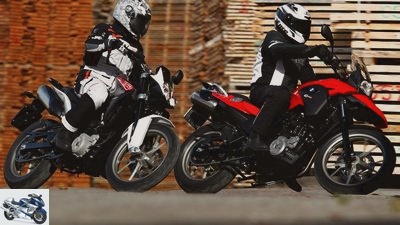
Gargolov
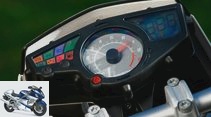
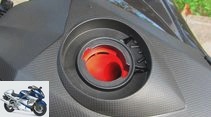
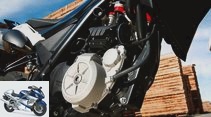

13 photos
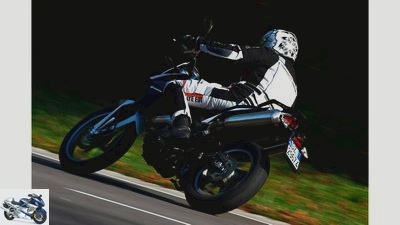
Gargolov
1/13
The Strada leads to a brisk pace on the route.

Gargolov
2/13
Not perfect, but with a temperature display and average consumption.
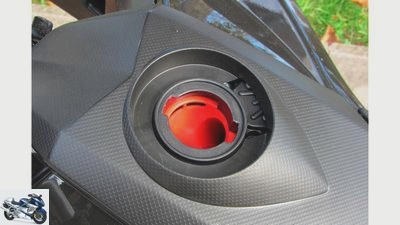
Gargolov
3/13
Something like that can be annoying: the red insert makes refueling the Husqvarna TR 650 Strada unnecessarily cumbersome.

Gargolov
4/13
Famous single cylinder at the Husqvarna, which runs extremely quietly and very easy to turn. Perfect!
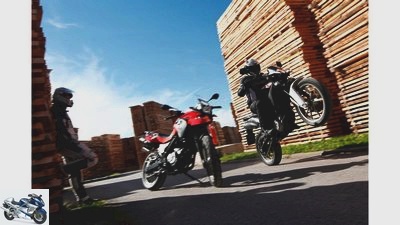
Gargolov
5/13
The Husqvarna TR 650 Strada and BMW G 650 GS in a comparison test.
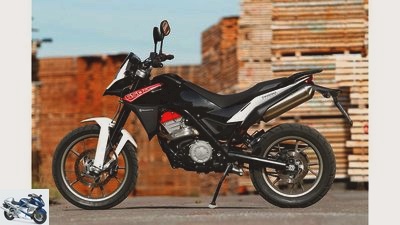
Gargolov
6/13
Husqvarna TR 650 Strada – a convincing motorcycle thanks to the modified single cylinder.
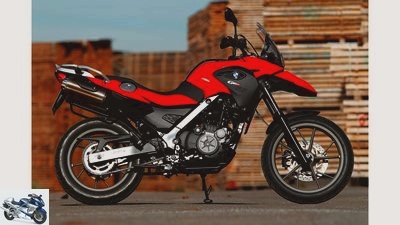
Gargolov
7/13
BMW G 650 GS – an uncomplicated all-rounder.
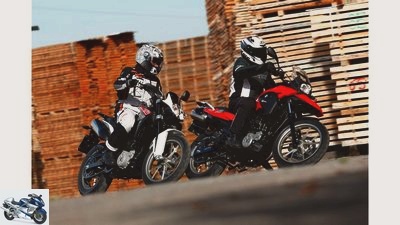
Gargolov
8/13
In comparison are the BMW G 650 GS and Husqvarna TR 650 Strada.
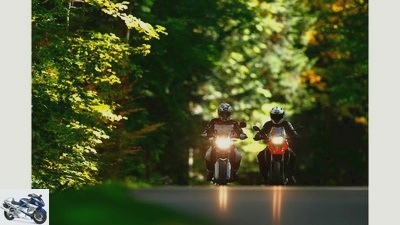
Gargolov
9/13
Both the BMW and the Husqvarna can cruise through the forest.
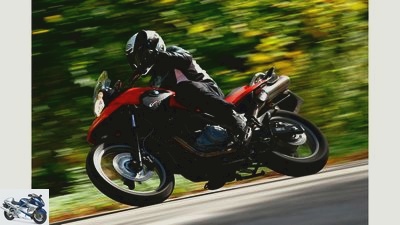
Gargolov
10/13
Despite its weight, the BMW drives robustly and develops linear propulsion.
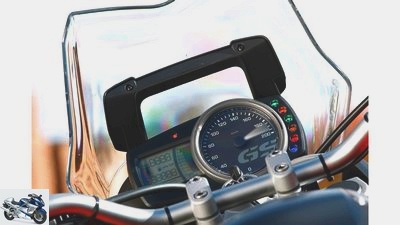
Gargolov
11/13
The cockpit of the G 650 GS offers little information, the digital tachometer is difficult to read.
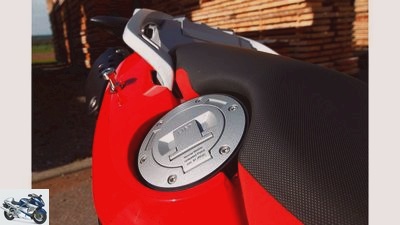
Gargolov
12/13
The BMW G 650 GS refuel at the rear, which can be annoying with a lot of luggage.
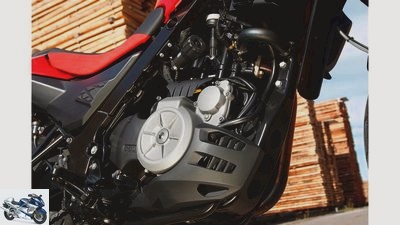
Gargolov
13/13
The BMW engine is already in the base well in the forage, but vibrates very indecently.
The all-rounders from BMW and Husqvarna in the test
BMW G 650 GS and Husqvarna TR 650 Strada in comparison
After Husqvarna Nuda 900 and TE 449, the third model follows with support from Bavaria: The Italians modified the large BMW single-cylinder for the TR 650 Strada. A comparison with the Munich original clarifies whether this is crowned with success.
The sonorous roar of the large single cylinder floods the underground car park. You immediately vanish from the fanaticism of performance, at the same moment you feel transported back to the beginnings of your motorcycle career. It is wonderful how the fat piston stomps up and down again, every combustion cycle is reflected through the closed space. Motorcycling can be so nice even when standing still! The new Husqvarna TR 650 Strada is no prole, but acoustically it already gives an idea that it is of a considerably different caliber than the somewhat conservative-looking and tight-sounding BMW G 650 GS standing next to it. It’s not really that surprising, but it’s quite interesting. Because the same single cylinder works in both candidates, which was already used in the old F 650 GS (until 2007). An old friend, so to speak. Built and proven thousands of times in China by Loncin, which is why the Strada engine is also manufactured there.
D.och, Husqvarna – at least since the takeover by BMW – would not be Husqvarna if they didn’t give the engine a lot more steam with a number of modifications. In contrast to the Nuda 900 model, which is based on the in-line twin cylinder of the F 800 R, this time there is no need to increase the displacement, but the young Wilde should nominally push 10 hp more than her – let’s say – organ donor. Whether this is at the expense of smoothness and suitability for everyday use? When interpreting an independent single-cylinder motorcycle, the Italians have at least made a lot of effort to differentiate themselves visually and technically from the BMW counterpart – you can see that at first glance: new steel bridge frame, fancier swingarm, an upside-down fork from Sachs with 190 millimeters of spring travel, very narrow silhouette, over two degrees steeper steering head angle. So there can be no question of a cheap copy of the BMW, and it is not so important that the handlebars and fittings, the rims and the brake units come from the same parts shelf as the small GS.
Buy complete article
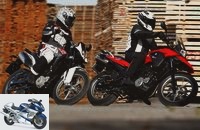
The all-rounders from BMW and Husqvarna in the test
BMW G 650 GS and Husqvarna TR 650 Strada in comparison
Gargolov
Despite its weight, the BMW is robust and develops linear propulsion.
The clutch can be dosed precisely, and the motor pushes the bike forwards powerfully and without any gaps as soon as it starts. However, you shouldn’t be too timid with the throttle grip. Then it sometimes “bopp” and the engine stops. It’s the same with BMW. Big single cylinders. So go on! In Stuttgart’s city traffic, both mopeds have to roll in slowly first. It’s amazing how gently the Husqvarna engine hangs on the gas – despite the substantial extra power. He reacts directly and without any nervousness to changes in the throttle valve position, accelerates the 188 kilogram Strada from 2000 revolutions with even power output, never hacks on the chain. That is a very promising announcement – but one that BMW can skilfully parry in this regard. Will it stay that way??
Curvy country roads are finally in sight. Then fire can be given. Despite its weight of 198 kilograms, the BMW is robust and develops a linear propulsion up to the limiter of 7400 revolutions. The measured 52 HP might not knock you off your feet, but it is enough to accelerate quickly out of the corners with plenty of torque. While the G can still be moved extremely easily at low speed and easily tilted into an inclined position, a little force on the handlebars is required when driving quickly. Once turned into the bend, however, the BMW stoically and very neutrally follows the targeted line. The fact that the damping front and rear (the spring strut can be adjusted in the spring base and rebound) is more comfortable, fits the overall concept and is also acceptable because the motorcycle does not rock worryingly at brisk pace and pocky asphalt. A successful, pretty sensible presentation of the BMW.
Gargolov
The Strada leads to a brisk pace on the route.
And the Strada? She now wants to show what is really in her. The Husqvarna climbs through the rev range with a good portion of ease, adds a few briquettes at around 5000 revs and easily pulls past the Mini-GS up to the maximum revs of 8500 revs. The fascinating thing about it:
No significant vibrations penetrate the driver over the entire speed range. It was completely different on the BMW, wasn’t it? The direct comparison follows again, then it is clear: The numerous modifications to the engine have not only increased the performance to a measured and tangible 59 hp, but also resulted in an astonishing smoothness. As smoothly as the single cylinder runs in the Husqvarna, it rattles as much in the BMW.
The Strada engine features a lighter forged piston, weight-reduced crankshaft and balance shaft, a new cylinder head with camshaft and larger inlet and outlet valves. Finally, the compression was also increased from 11.5 to 12.3. All measures have done the drive extremely good. The additional consumption of 0.3 liters per 100 kilometers is therefore really okay. The base engine in the BMW has to admit defeat. Chapeau!
Gargolov
The Husqvarna TR 650 Strada and BMW G 650 GS in a comparison test.
Unfortunately, the Husqvarna is not quite as civil and balanced on the chassis side. If it is a bit more maneuverable than the G, especially at higher speeds, it cannot be turned as precisely and precisely on the slow course. On the other hand, it lies more solidly on the road in an inclined position and provides better feedback to the driver. It’s a shame that the non-adjustable Sachs fork responds so badly and chugs over bumps quite unabashedly. Otherwise the feeling for the front wheel would be even better. The sporty, stiff shock absorber, which can be adjusted in terms of the spring base and rebound damping, doesn’t need any criticism. However, this does not apply to the ABS-assisted brakes of both test candidates, which are standard equipment on both machines. These require a lot of manual strength for only average deceleration services.
All in all, the cheaper Husqvarna surprises its rival from the same company with a grandiose single cylinder. Ultimately, however, it remains a matter of taste: the BMW is a decent touring bike, the Strada is more for the young dynamic. Fortunately, you’re only as old as you feel. Thank you Husqvarna – and BMW.
Scoring
Gargolov
BMW G 650 GS and Husqvarna TR 650 Strada.
engine
The modified engine in the Husqvarna is a magnificent single cylinder. Compared to the BMW, it is not only significantly more powerful and more powerful, but also plays in a different league in terms of smoothness. In turn, both can boast low load changes and a decent transmission. On the other hand, they acknowledge cold starts with a high idle speed.
Winner engine: Husqvarna
landing gear
The TR 650 Strada only barely wins this chapter. The poorly responding upside-down fork and a slight swing around the longitudinal axis at high speed prevent better cutting. The BMW shows itself from the solid, comfortable side. On the other hand, the feedback is a bit worse, and the side stand touches down quite early in left turns.
Chassis winner: Husqvarna
everyday life
Here the hour of the G 650 GS strikes. Those who go on a big tour prefer to use the BMW. The passenger sits better, there is a bit of wind protection and if it gets dark, the light illuminates the road properly. The Strada offers its driver a nice place, but fails with wind protection, light and workmanship. Both offer long ranges, the BMW even up to 400 kilometers.
Winner everyday life: BMW
security
The brakes aren’t great on either. The identically constructed single-disc brakes at the front require high manual forces for only moderate deceleration. The ABS regulates roughly, but safely.
Safety winner: Husqvarna
costs
The BMW is more economical. Because of the 10,000 intervals, both (presumably) don’t need to be inspected too often.
Winner costs: BMW
Price-performance
The Strada costs significantly less and offers a lot for it. A real recommendation.
Price-performance winner: Husqvarna
| Max points | BMW G 650 GS | Husqvarna TR 650 Strada | Overall rating | 1000 | 590 | 592 |
| placement | 2. | 1. | Price-performance note | 1.0 | 1.8 | 1.5 |
Gargolov
Husqvarna TR 650 Strada – a convincing motorcycle thanks to the modified single cylinder.
Husqvarna TR 650 Strada
The modified BMW single-cylinder is convincing all along the line and can score so many points that it is ultimately enough for victory. Except for the fork set-up and the poor brakes a really great, not too radical motorcycle.
Gargolov
BMW G 650 GS – an uncomplicated all-rounder.
BMW G 650 GS
A direct comparison reveals it: the original single cylinder generates more vibrations with less power. Otherwise the GS remains an all-rounder. Uncomplicated, solid and well made. Only the brakes should tackle more research.
Data and performance measurements
Gargolov
Both the BMW and the Husqvarna can cruise through the forest.
| BMW G 650 GS | Husqvana TR 650 Strada | |
| engine | ||
| design type | Single cylinder four-stroke engine | Single cylinder four-stroke engine |
| injection | Ø 43 mm | Ø 43 mm |
| coupling | Multi-disc oil bath clutch | Multi-disc oil bath clutch |
| Bore x stroke | 100.0 x 83.0 mm | 100.0 x 83.0 mm |
| Displacement | 652 cm3 | 652 cm3 |
| compression | 11.5: 1 | 12.3: 1 |
| power | 35.0 kW (48 hp) at 6500 rpm | 43.0 kW (58 hp) at 7250 rpm |
| Torque | 60 Nm at 5000 rpm | 60 Nm at 5750 rpm |
| landing gear | ||
| frame | Bridge frame made of steel | Bridge frame made of steel |
| fork | Telescopic fork, Ø 41 mm | Upside-down fork, Ø 46 mm |
| Brakes front / rear | Ø 300/240 mm | Ø 300/240 mm |
| Assistance systems | SECTION | SECTION |
| bikes | 2.50 x 19; 3.50 x 17 | 2.50 x 19; 3.50 x 17 |
| tires | 110/80 R 19; 140/80 R 17 | 110/80 R 19; 140/80 R 17 |
| Tires | Metzeler Tourance EXP, front “B” | Metzeler Tourance EXP |
| DIMENSIONS + WEIGHTS | ||
| wheelbase | 1477 mm | 1501 mm |
| Steering head angle | 61.9 degrees | 64.0 degrees |
| trailing | 113 mm | 101 mm |
| Front / rear suspension travel | 170/165 mm | 190/190 mm |
| Seat height ** | 790-820 mm | 865 mm |
| Weight with full tank ** | 198 kg | 188 kg |
| Payload ** | 182 kg | 196 kg |
| Tank capacity / reserve | 14.0 / 0 liters | 14.0 / 0 liters |
| Service intervals | 10000 km | 10000 km |
| price | 7300 euros | 6690 euros |
| Price test motorcycle | 7618 euros *** | 6690 euros |
| Additional costs | 390 euros | 300 Euro |
| MOTORCYCLE readings | ||
| Top speed * | 170 km / h | 175 km / h |
| acceleration | ||
| 0-100 km / h | 5.1 sec | 4.8 sec |
| 0-140 km / h | 11.3 sec | 9.6 sec |
| Draft | ||
| 60-100 km / h | 5.7 sec | 5.1 sec |
| 100-140 km / h | 7.5 sec | 6.7 sec |
| Consumption highway | 3.5 liters / normal | 3.8 liters / super |
| Reach country road | 400 km | 368 km |
* Manufacturer information
** MOTORCYCLE measurements
***Incl. Main stand 121 euros, including heated grips 197 euros

motorcycles
Behind the scenes of the 1000-point evaluation
Special: This is how MOTORRAD tests
read more
Performance measurement of the BMW G 650 GS and Husqvarna TR 650 Strada
The BMW and Husqvarna engines develop their power very homogeneously. Both provide a lot of torque from idle. The kink in the curve of the Strada is not really noticeable. The extra power from around 5000 revs, however, already. Subjectively, the Husqvarna pushes through the rev range with greater ease. Also recognizable: the different maximum speeds.
Modifications to the single cylinder of the Strada
Gargolov
Famous single cylinder at the Husqvarna, which runs extremely quietly and very easy to turn. Perfect!
• New cylinder head with flow-optimized inlet and outlet ports
• New fuel injection system
• Diameter of the inlet valves increased from 36 to 38.5 millimeters, exhaust valves from 31 to 34 millimeters
• Camshaft with longer valve timing, new valve lift curves and increased valve lifts
• Compression ratio increased from 11.5 to 12.3: 1
• Forged pistons lighter by 112 grams in comparison to the BMW weight-reduced crankshaft and balance shaft
• redesigned airbox
• New stainless steel exhaust system with two rear silencers
Related articles
-
Jahn 35 pictures Jahn 1/35 Husqvarna TC 250 R in the motocross comparison test. Jahn 2/35 Yamaha YZ 250 F in the motocross comparison test. Jahn 3/35 Husqvarna TC …
-
Husqvarna 701 Supermoto and KTM 690 SMC R in a comparison test
factstudio.de 16 photos factstudio.de 1/16 KTM 690 SMC R and Husqvarna 701 Supermoto. KTM 2/16 The shaft made: the second balancer shaft is housed in the…
-
Husqvarna TR 650 Strada – Terra
Fig. 8 pictures Fig. 1/8 Husqvarna TR 650 Strada. Bildl 2/8 Strada (left) and Terra not only share the chassis, motor and spring travel, but also the …
-
Husqvarna FE 350 and Husqvarna TE 300i in a comparison test
Husqvarna FE 350 and Husqvarna TE 300i in the comparison test Cloudy to clear The days of blue two-stroke clouds are (almost) over. Because with…
-
350cc sport enduro bikes from Beta, Husqvarna, KTM and Sherco in a comparison test
Gargolov 22nd photos Gargolov 1/22 350 series enduro bikes in comparison: Beta RR 350 EFI, Husqvarna FE 350, KTM 350 EXC-F and Sherco 300 SEF-R. Gargolov…
-
Comparison test: Aprilia, BMW, Husqvarna, KTM and Yamaha
fact comparison test: Aprilia, BMW, Husqvarna, KTM and Yamaha single-cylinder fun bikes They have a big heart, a very big one. The new…
-
Husqvarna 701 SM and KTM 690 SMC R in comparison test
bilski-fotografie.de 14th photos www.bilski-fotografie.de 1/14 In contrast to the Husqvarna, the KTM cockpit is valuable and is highly suitable for…
-
BMW, Kawasaki, Triumph and Yamaha Tourer in comparison test
Gargolov 31 pictures Gargolov 1/31 Tourer comparison test: Triumph Trophy SE, BMW R 1200 RT, BMW K 1600 GT, Yamaha FJR 1300 and Kawasaki 1400 GT. Gargolov …
-
Comparison test between Husqvarna Vitpilen 701 and KTM 690 Duke
r-photography.info 20 pictures r-photography.info 1/20 Husqvarna Motorcycles Vitpilen 701 and KTM 690 Duke in comparison. r-photography.info 2/20 …
-
Comparison test Husqvarna SM 610, KTM 640 LC4 Supermoto
Artistic comparison test Husqvarna SM 610, KTM 640 LC4 Supermoto scraper brushes Autobahn, luggage system, pillion suitability ?? Supermoto bikes interested …